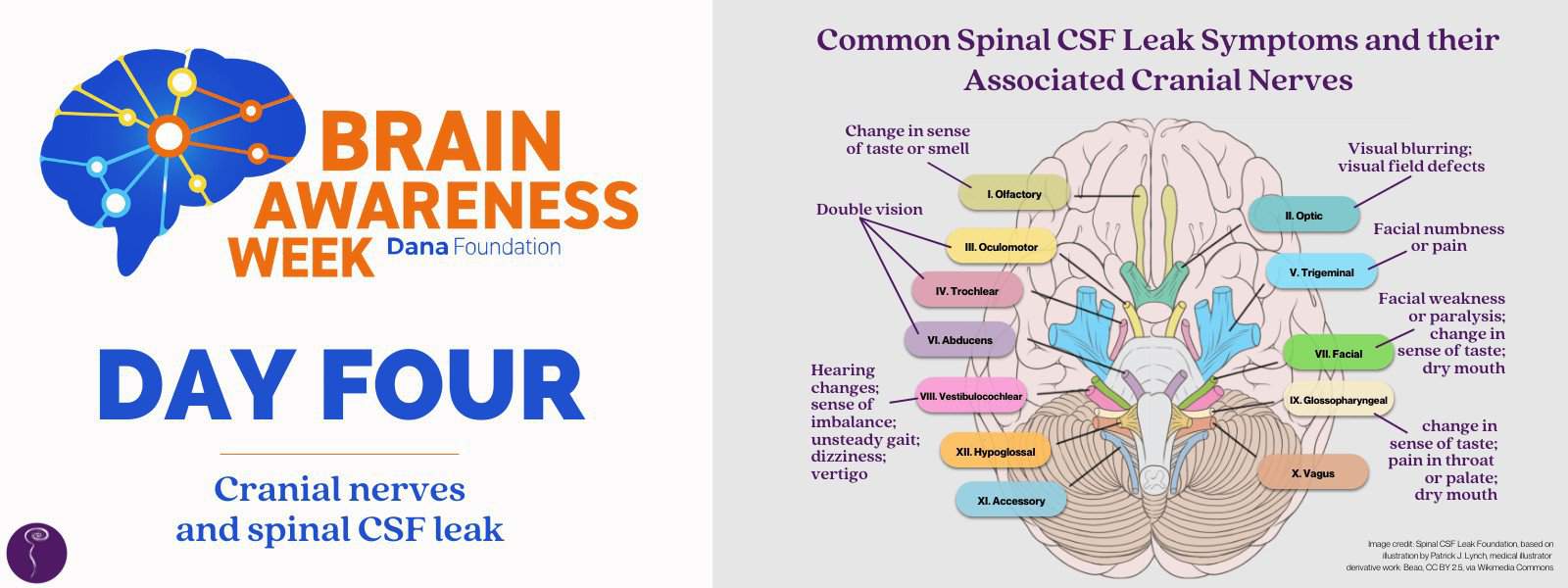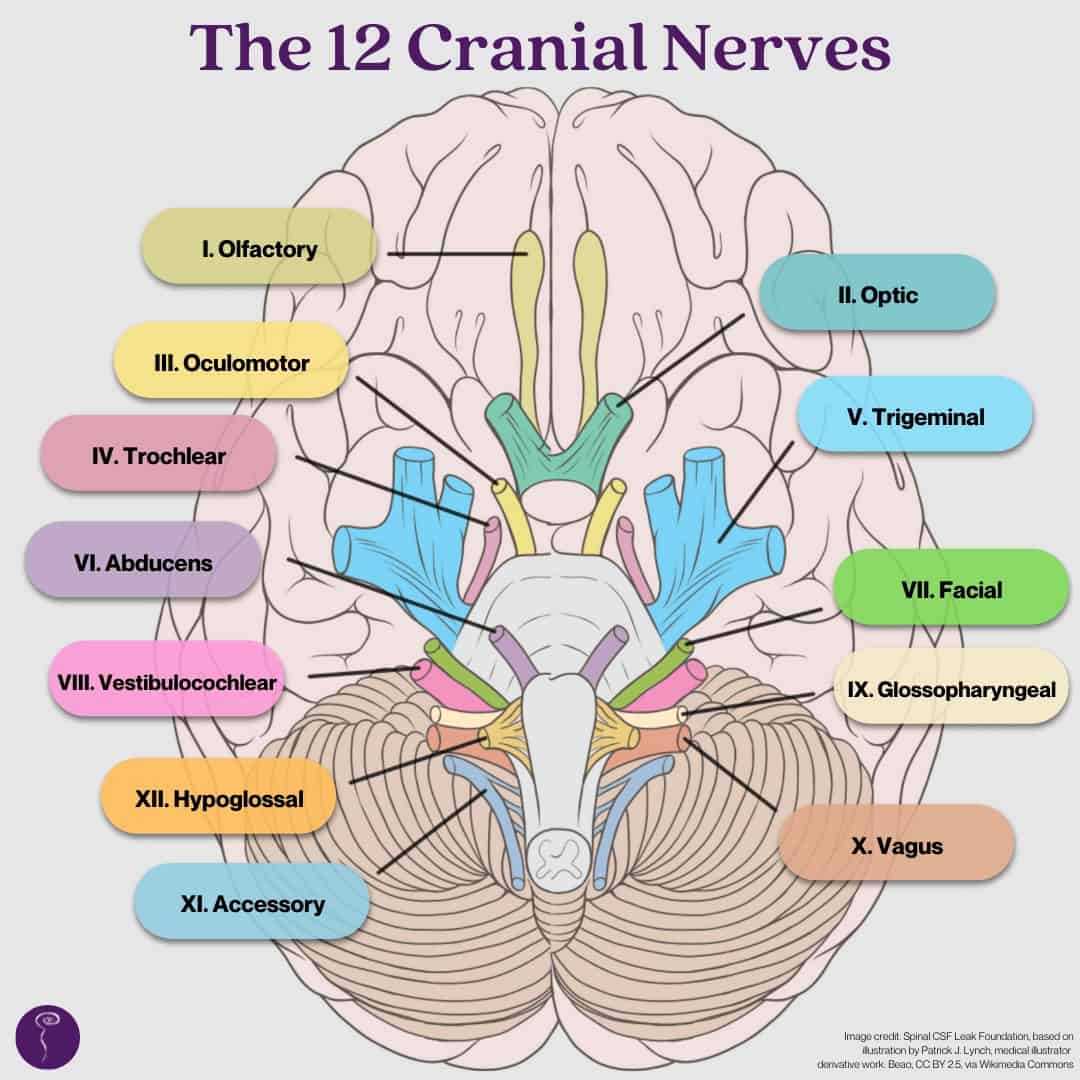
Cranial Nerves and Spinal CSF Leak
For day four of Brain Awareness Week, we’re discussing the impact of spinalcerebrospinal fluid (CSF) leak on cranial nerves. The cranial nerves are a group of 12 paired nerves that start in the back of your brain and extend into your body. These nerves send electric signals between your brain, face, neck, and torso, and help you hear, feel, touch, see, smell, taste, and more.
The brain sag caused by intracranial hypotension (low volume of cerebrospinal fluid in the skull) due to spinal CSF leak can affect cranial nerves, causing neurological symptoms. Some cranial nerves are affected more commonly than others. Below is an overview of the cranial nerves and the common symptoms of cranial nerve dysfunction in the setting of spinal CSF leak.
The Cranial Nerves
I. The olfactory nerve. This is associated with sense of smell and taste.
II. The optic nerve. This is associated with vision.
III. The oculomotor nerve. This is associated with eye movement (the ability to move and blink your eyes) and pupil reflex.
IV. Trochlear nerve. This is also associated with eye movement, allowing the eye to point downward, outward, and inward.
V. Trigeminal nerve. This is the largest cranial nerve. Is associated with functions involving your eyes, ears, cheeks, and face, including facial sensations and chewing.
VI. Abducens nerve. This is also associated with eye movement, including the muscles that enable you to look to the side.
VII. Facial nerve. This is associated with facial movement—the movement of muscles used in facial expressions—and taste.
VIII. Vestibulocochlear nerve. This is associated with hearing and balance.
IX. Glossopharyngeal nerve. This is associated with motor and sensory functions in the throat, including the ability to taste and swallow.
X. Vagus nerve. This is the longest cranial nerve, starting in the medulla and extending all the way to the abdomen. It is associated with everything from digestion and heart rate to movement of the throat and soft palate, to parasympathetic functions of regulating heart rhythm and innervating smooth muscles in airway, lungs, and the gastrointestinal tract.
XI. Accessory nerve. This is associated with motor function in the neck and shoulder muscles.
XII. Hypoglossal nerve. This supplies the tongue muscles.

How are cranial nerves affected in spinal CSF leak?
The brain sagging often seen in patients experiencing spinal CSF leak can affect many of the cranial nerves. Some of the most common symptoms include:
- Visual defects (second cranial nerve)
- Diplopia (double vision) (third, fourth, and sixth cranial nerves)
- Hearing changes such as phonophobia, muffled hearing, or tinnitus; a sense of imbalance or unsteady gait; dizziness; vertigo (eighth cranial nerve; other mechanisms, including changes in fluid levels in the inner ear, may also be involved)
- Facial numbness or pain (fifth cranial nerve)
- Facial weakness or paralysis (seventh cranial nerve)
- Changes in sense of taste (first, seventh, or ninth cranial nerves)
- Pain in throat or palate (ninth cranial nerve)
- Changes in sense of smell (first cranial nerve)
- Dry mouth (seventh or ninth cranial nerve)
Recent research
In a 2023 Journal of Neuroimaging study titled “Cranial nerve abnormalities in spontaneous intracranial hypotension and their clinical relevance,” researchers looked at brain MRIs of patients diagnosed with SIH to see if they could detect enhancement of cranial nerves associated with visual changes (cranial nerves 3 and 6) and hearing changes/vertigo (cranial nerve 8).
What they found was that patients who had cranial nerve findings on MRI were more likely to have symptoms like vision changes, diplopia, hearing changes, and/or vertigo than those patients without imaging findings.
The paper concluded: “Cranial nerve abnormalities on brain MRI should be reported in suspected SIH patients as they may support the diagnosis and explain patient symptoms.”
Cranial nerves and spinal CSF leak symptoms
Below is an illustration of the 12 cranial nerves and the common spinal CSF leak symptoms associated with them.

Further viewing:
To learn more, watch Dr. Deborah Friedman’s presentation on cranial nerve involvement in SIH at the 2020 Cedars-Sinai Intracranial Hypotension Symposium.
